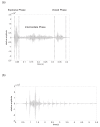Cough and its importance in COPD
- PMID: 18046867
- PMCID: PMC2707150
- DOI: 10.2147/copd.2006.1.3.305
Cough and its importance in COPD
Abstract
Patients with COPD most frequently complain of breathlessness and cough and these are both increased during exacerbations. Studies have generally focused on quality of life during end-stage disease, where breathlessness becomes dominant and cough less important. There are very little data on the frequency and severity of cough in COPD or its impact on quality of life at different stages of disease. Little is known about the factors that influence objective cough counts in COPD. Cough may be a marker for progressive disease in milder COPD patients who continue to smoke, and it may be useful in case-finding for milder disease in the community.The cough reflex sensitivity is heightened in COPD compared with healthy volunteers and similar to that in subjects with asthma. The degree of airflow obstruction does not predict cough reflex sensitivity or objective cough counts, implying an independent process. Effective treatments for cough in COPD have not yet been identified. Improved outcome measures of cough, a better understanding of cough in the natural history of COPD, and its importance to patients are needed.
Figures





Similar articles
-
Cough in chronic obstructive pulmonary disease.Pulm Pharmacol Ther. 2004;17(6):393-8. doi: 10.1016/j.pupt.2004.09.006. Pulm Pharmacol Ther. 2004. PMID: 15564082 Review.
-
The Relationship Between Cough Reflex Sensitivity and Exacerbation Frequency in Chronic Obstructive Pulmonary Disease.Lung. 2020 Aug;198(4):617-628. doi: 10.1007/s00408-020-00366-x. Epub 2020 Jun 19. Lung. 2020. PMID: 32561993 Free PMC article.
-
Cough-reflex sensitivity to inhaled capsaicin in COPD associated with increased exacerbation frequency.Respirology. 2009 Nov;14(8):1151-5. doi: 10.1111/j.1440-1843.2009.01620.x. Epub 2009 Sep 16. Respirology. 2009. PMID: 19761536 Clinical Trial.
-
Capsaicin responsiveness and cough in asthma and chronic obstructive pulmonary disease.Thorax. 2000 Aug;55(8):643-9. doi: 10.1136/thorax.55.8.643. Thorax. 2000. PMID: 10899239 Free PMC article.
-
Exacerbations of chronic obstructive pulmonary disease.Respir Care. 2003 Dec;48(12):1204-13; discussion 1213-5. Respir Care. 2003. PMID: 14651761 Review.
Cited by
-
Identification of symptom clusters and change trajectories in patients with acute exacerbation of chronic obstructive pulmonary disease.Heliyon. 2024 Jul 4;10(13):e33745. doi: 10.1016/j.heliyon.2024.e33745. eCollection 2024 Jul 15. Heliyon. 2024. PMID: 39071711 Free PMC article.
-
Minimal Clinically Important Differences for Patient-Reported Outcome Measures of Cough and Sputum in Patients with COPD.Int J Chron Obstruct Pulmon Dis. 2020 Jan 29;15:201-212. doi: 10.2147/COPD.S219480. eCollection 2020. Int J Chron Obstruct Pulmon Dis. 2020. PMID: 32099345 Free PMC article.
-
Effects of four antitussives on airway neurogenic inflammation in a guinea pig model of chronic cough induced by cigarette smoke exposure.Inflamm Res. 2013 Dec;62(12):1053-61. doi: 10.1007/s00011-013-0664-6. Epub 2013 Oct 2. Inflamm Res. 2013. PMID: 24085318
-
Motivation to quit smoking and acceptability of shocking warnings on cigarette packages in Lebanon.Patient Prefer Adherence. 2017 Feb 24;11:331-342. doi: 10.2147/PPA.S122877. eCollection 2017. Patient Prefer Adherence. 2017. PMID: 28280306 Free PMC article.
-
Reactive Oxygen Species in Chronic Obstructive Pulmonary Disease.Oxid Med Cell Longev. 2018 Feb 11;2018:5730395. doi: 10.1155/2018/5730395. eCollection 2018. Oxid Med Cell Longev. 2018. PMID: 29599897 Free PMC article. Review.
References
-
- Bennett WD, Chapman WF, Mascarella JM. The acute effect of ipratropium bromide bronchodilator therapy on cough clearance in COPD. Chest. 1993;103:488–95. - PubMed
Publication types
MeSH terms
Substances
LinkOut - more resources
Full Text Sources
Other Literature Sources
Medical

